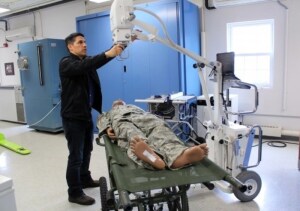From the November 2017 issue of HealthCare Business News magazine
By Heather Poulin
Regarded as the standard of radiology today, digital radiography (DR) has come a long way since its inception to provide benefits for patients and technicians alike.
What was once an expensive, high-X-ray-dosage and non-portable solution has given way to more affordable technology that now offers mobility, relatively low X-ray dosage and exposure to patients, wireless capabilities and high-resolution imaging.
As more health care facilities transition from film and computed radiography (CR) to digital radiography solutions (further incentivized by a Congressional initiative to convert by 2020), it is worth noting some key milestones that have marked the rise of DR technology – and consider what advances are still to come:
Digital radiography emerges: The first DR system appeared in 1990, 10 years following the introduction of CR in 1980. From that point, the technology continued to expand and evolve, particularly in the development of flat-panel and portable detectors. In 1997, Canon Inc. introduced the first Canon DR panel to the market: the CXDI-11 Digital Radiography System.
Early advantages: From the outset, the benefits of DR were apparent. The ability of digital detectors to preserve the quality of the original image and store files for easy access gave DR an edge that CR did not have. Industry professionals recognized that the technological advancements made with DR would help diagnostic imaging professionals capture and process an image faster, allowing them to see more patients with less radiation exposure to the patient than previously available radiography methods. This reduction in X-ray dose has an obvious direct effect for the patient, but may be overlooked as it relates to imaging technologists.
Recent innovations: As the needs of the industry have evolved, so has the technology. Whereas in the past DR systems may have only been stationed in a doctor’s office or medical facility, they are now being utilized in a variety of settings. To help improve the versatility of the device, the need for units to be durable, lightweight and more mobile emerged. With organizations such as the United States Department of Defense utilizing mobile DR devices in high-intensity environments, the ability to sustain wear and tear has become a key feature it looks to in its systems.
What’s next for DR?
While the rapid evolution of digital radiography has addressed many unmet needs, it raises new questions for industry leaders moving forward, especially with new legislation helping to accelerate the adoption of DR in health care facilities. With the Consolidated Appropriations Act of 2016 decreasing Medicare reimbursements for film and CR use, health care facilities that have not already transitioned to DR must find ways to implement DR at a pace that is in line with their budget and business model at the risk of being left behind. Fortunately, some manufacturers are offering budgetary and strategic initiatives to help customers make the transition.
